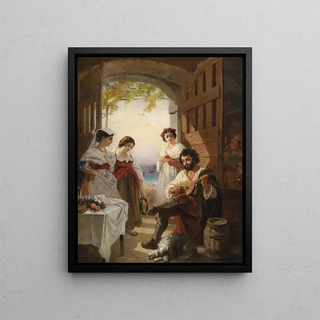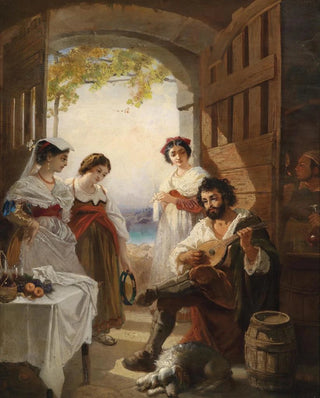Napolitan Tavern - Anton Romako | Art print


View from behind

Frame (optional)
In the vast panorama of European art, certain works stand out for their ability to capture the essence of a particular era and place. "Napolitan Tavern - Anton Romako" is one such piece that transports us to the heart of daily life in Naples, a vibrant city full of contrasts. Through this painting, Romako invites us to share a moment of conviviality, where the characters, frozen in a moment of relaxation, seem to whisper stories of their lives. The warm atmosphere emanating from this tavern scene resonates with such authenticity that it almost makes us forget the passage of time.
Style and uniqueness of the work
Romako's style is characterized by a remarkable mastery of light and color, essential elements that breathe life into his compositions. In "Napolitan Tavern," warm hues and delicately worked shadows create an intimate ambiance, conducive to meeting and exchange. The characters, although frozen, exude a palpable energy, bearing witness to a moment of sharing and conviviality. The way the artist plays with textures, from the characters' clothing to the surfaces of wooden tables, adds a tactile dimension to the work. Every detail, whether it’s the filled glasses or exchanged smiles, contributes to the authenticity of the scene and the visual storytelling unfolding within. Romako thus manages to capture not only an image but also an atmosphere, an emotion, making this piece deeply immersive.
The artist and his influence
Anton Romako, an Austrian-born painter, established himself in the 19th-century art scene thanks to his exceptional talent and unique vision. Influenced by the realistic currents of his time, he developed a personal style that combines meticulous observation with artistic sensitivity. Romako often explored themes related to daily life, seeking to immortalize simple yet meaningful moments. His humanist approach, centered on the individual and their interactions, finds a particular resonance in "Napolitan Tavern." By capturing the essence of Neapolitan conviviality, he reminds us of the importance of human connections in our experience.

Matte finish

View from behind

Frame (optional)
In the vast panorama of European art, certain works stand out for their ability to capture the essence of a particular era and place. "Napolitan Tavern - Anton Romako" is one such piece that transports us to the heart of daily life in Naples, a vibrant city full of contrasts. Through this painting, Romako invites us to share a moment of conviviality, where the characters, frozen in a moment of relaxation, seem to whisper stories of their lives. The warm atmosphere emanating from this tavern scene resonates with such authenticity that it almost makes us forget the passage of time.
Style and uniqueness of the work
Romako's style is characterized by a remarkable mastery of light and color, essential elements that breathe life into his compositions. In "Napolitan Tavern," warm hues and delicately worked shadows create an intimate ambiance, conducive to meeting and exchange. The characters, although frozen, exude a palpable energy, bearing witness to a moment of sharing and conviviality. The way the artist plays with textures, from the characters' clothing to the surfaces of wooden tables, adds a tactile dimension to the work. Every detail, whether it’s the filled glasses or exchanged smiles, contributes to the authenticity of the scene and the visual storytelling unfolding within. Romako thus manages to capture not only an image but also an atmosphere, an emotion, making this piece deeply immersive.
The artist and his influence
Anton Romako, an Austrian-born painter, established himself in the 19th-century art scene thanks to his exceptional talent and unique vision. Influenced by the realistic currents of his time, he developed a personal style that combines meticulous observation with artistic sensitivity. Romako often explored themes related to daily life, seeking to immortalize simple yet meaningful moments. His humanist approach, centered on the individual and their interactions, finds a particular resonance in "Napolitan Tavern." By capturing the essence of Neapolitan conviviality, he reminds us of the importance of human connections in our experience.
12,34 €






